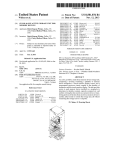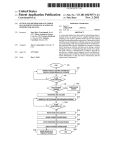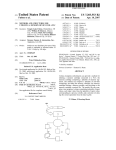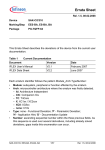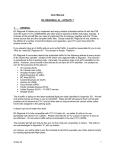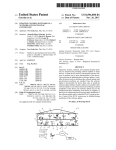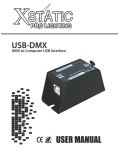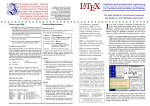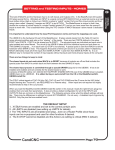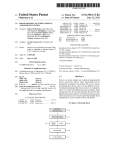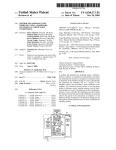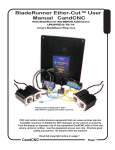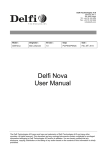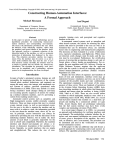Download I865` 222
Transcript
US 20070097793Al (19) United States (12) Patent Application Publication (10) Pub. No.: US 2007/0097793 A1 Nguy et al. (54) (43) Pub. Date: ELECTRONIC TIMER (52) May 3, 2007 US. Cl. .............................................................. .. 368/15 (76) Inventors: Samuel Eak Hua Nguy, Hong Kong (CN); George Carl Atamian, Upland, CA (U S) (57) ABSTRACT Correspondence AddreSSI An electronic timer having a memory for storing program Ketall 5- Vakil, Esq- ming information including astronomical sunset, sunrise, SNELL & WILMER L-L-Psuite 1400 600 Anton Boulevard evening, daWn or tWilight data for at least one geographic location, a processor for generating a time controlled signal; and a sWitch, responsive to the time controlled signal, for receiving an input poWer from a poWer supply and coupling Costa Mesa’ CA 926264689 (Us) (21) APPI' NO‘: 11/265,969 (22) N0“ 3, 2005 data can be used 1n setting an operatlng t1me correspondlng to the geographic location of the user. Each AC socket can Publication Classi?cation further includes a random selection unit used to randomly Filed: the input poWer to at least one AC socket: The astronomical operate independently from the other. The electronic timer select an activation and/or deactivation times based on a (51) Int. Cl. G04B 19/26 number of setting parameters that provides a different oper ating time for each day of the year and for each AC socket. (2006.01) 130 < . ) 8888-88-88 I865’ 222 ON R OFF L 150 \ 160 180 v) Patent Application Publication May 3, 2007 Sheet 1 0f 7 US 2007/0097793 A1 13.0 , A< ‘ .7” L _ ‘200 ' 3 _7L7 M15335 bu / 110 ZQF’Z I855’ 252 150 ' \- SET ' 140 wt VFIG.1_ Patent Application Publication May 3, 2007 Sheet 2 0f 7 US 2007/0097793 A1 /100 200 170 FIG. 2 Patent Application Publication May 3, 2007 Sheet 3 0f 7 US 2007/0097793 A1 100 110 310 _ 300 Patent Application Publication May 3, 2007 Sheet 4 0f 7 N1 OD. x0510 ‘aF 62 2 c.l .1 6I US 2007/0097793 A1 3.2 ; <9E8.E62953 Q 2NU NV. 7Z8 01*_ 2 ".52. 1 00+ main: 32=E€.o6|52£= NB n I 3 " a a uacm 1a|iIul|Iiv1|I Patent Application Publication May 3, 2007 Sheet 5 0f 7 US 2007/0097793 A1 Display unit 130 A w 515 Input device 140 510 \ ' ‘ ' 405 A w 530 . 535 Batterles ————> 415 520w Power management - 525 V 540 Relay 7 V 120V,15A input _ '> control ' 545 Output 120V,15A. 550 . R - 555 L Patent Application Publication May 3, 2007 Sheet 6 0f 7 US 2007/0097793 A1 ( Start )/-60O V 605 Initialize Parameters v 610 Set City Code V Set Date Mode User Inputs the Following: ,- 615 1. Year 2. Month 3. Day V Set Clock Mode User Inputs the Following: ,- 620 1. Hour 2. Minute Select Random Selection Unit 1. On 2. Off V , - Set Mode of Operation 1. Program Mode /- 630 2. Auto Mode 3. Mixed Mode‘ Program Mode 640 i Mixed Mode l 650 645 Patent Application Publication May 3, 2007 Sheet 7 0f 7 US 2007/0097793 A1 (‘ Start )f'700 V S'et City Code / 704 vr Set Year 705 r 710 r —> Set Month —> 715 Set Day r —> 720 ' » Set Hour / 725 —> Set Minutes 730 Default Settings Set to Default Activation Deact'Va-mn “me and Deactivation Times 745 f Set Activation Time of First AC Socket vf [735 V - Y Set Hours 755 f 750 _ V 760 F Set Minutes’ /' 765 Set Deactivation Time of First AC Socket ‘ Set Hours ' _ Set MlrluteS "(770 Set Activation Time of Second _ 7 Set Hours ' Set Hours v 7 > Set Minutes AC Socket ‘7 [775 Set Deactivation Time of Second AC Socket t FIG. 7 _ Set Minutes May 3, 2007 US 2007/0097793 A1 ELECTRONIC TIMER These devices, such as the one disclosed in US. Pat. No. 4,575,659, require a photocell arrangement that increase the FIELD OF THE INVENTION [0001] The invention relates generally to electronic timers that activate or deactivate electrical devices such as lights. More particularly, the invention relates to timers pro grammed to turn a light on and off at predetermined times that correspond to the geographic location of the user or at random times operating Within programmed temporal parameters. DESCRIPTION OF THE RELATED ART [0002] Conventional electrical timers are commonly used to turn lights on and off in a dWelling or business, thereby, giving the appearance that the premises is occupied. This helps in deterring burglars from breaking into the premises When its occupants are aWay. [0003] Electrical timers also provide illumination that helps reduce accidents associated With insuf?cient illumi nation. [0004] cost and complexity of the electronic timer unit. Further more, these photocell devices do not incorporate randomiZ ing features, nor can they be precisely programmed to activate and deactivate at set times. They are also restricted to activating one device as they have only one socket. [0008] While many of these timers Work to turn the lights on and off, they fail to accurately account for the different sunset times corresponding to the user’s geographic location and the time of year. Accordingly, it is an object of the present invention to provide an electronic timer that is programmed With accurate sunset and/or sunrise informa tion speci?cally for a user’s geographic locationilatitude and longitude. The latter determines the user’s location Within a given time Zone, Which is compensated by the programming in the electronics. BRIEF DESCRIPTION OF THE DRAWINGS [0009] The exact nature of this invention, as Well as the objects and advantages thereof, Will become readily appar One of the problems associated With these timers is ent from consideration of the folloWing speci?cation in that they turn on the same lights every night at the same selected activation time. One can easily ascertain that the conjunction With the accompanying draWings in Which like reference numerals designate like parts throughout the ?g house is not occupied by observing this repetitive operation over a period of days. Some timers alloW lights to turn on at random times Within a preselected random time interval of a selected activation time. Typically, the preselected random time interval is Within 15-20 minutes of the selected acti vation time. This random operation avoids the repetitive activation time of conventional electronic timers. Normally, the programming of multiple random times is so dif?cult that most consumers abandon the effort. [0005] Even the electronic timers With random operation have limitations. For instance, the timers may not adjust to ures thereof and Wherein: [0010] FIG. 1 is a front vieW of an actual electronic timer incorporating an embodiment of the present invention. [0011] FIG. 2 is a side vieW of an actual electronic timer incorporating an embodiment of the present invention. [0012] FIG. 3 is a top vieW of an actual electronic timer incorporating an embodiment of the present invention. [0013] FIG. 4 is a circuit design of an electronic timer incorporating an embodiment of the present invention. daylight savings time and Would require the user to update the timer’s clock setting. Furthermore, even if the timers are advanced enough to correct for daylight savings time, they do not adjust for the varying sunset times throughout the year. Hence, if a user sets the timer to turn on at around 9 pm [0014] FIG. 5 is a block design of an electronic timer incorporating an embodiment of the present invention. [0015] FIG. 6 is a How chart of the operation of an electronic timer incorporating an embodiment of the present invention. during the summer, he or she Will have to readjust the timer settings in the fall and Winter to correspond to an earlier sunset time. Adjustments are required more frequently When the sun is in the mid-latitudes, moving North or South. Most [0016] FIG. 7 is a How chart of a program executed by the processor in an electronic timer incorporating an embodi home or business oWners do not have the time or opportunity ment of the present invention. to constantly tune their timers. [0006] While US. Pat. No. 4,922,407 discloses an astro nomical timer unit that can be preset to operate at dusk or daWn, this system also has limitations. It requires the user to enter local time of sunrise or the local time of sunset on the particular month and day to Which the clock is currently set, SUMMARY OF THE INVENTION [0017] The present invention provides an electronic timer With stored astronomical data such as sunset, sunrise, evening, daWn or tWilight data, for a speci?c geographic location that is used in setting an activation time. and then uses an algorithm to calculate the subsequent times of local sunrise and sunset based on the time of year and the [0018] geographical location of the timer. Not only is this system susceptible to human error by virtue of entering the Wrong multiple geographic locations. A user selects a city or country from the data base, or simply enters a city or country sunset or sunrise times, it is also inaccurate because the algorithm only provides an estimate and not the exact sunset time. code, to trigger the processor to retrieve the appropriate [0007] Some electronic devices activate and deactivate their sWitching mechanism in response to photocell sensors. The sensor detects arrival of nighttime and automatically turns on the light after a certain time period from nightfall. The stored astronomical data could also be for astronomical data from memory. [0019] A random selection unit randomly selects a time in a pre-selected random time interval on either side of an activation time. For instance, the electronic timer can be set to randomly activate Within a pre-selected of 15 minute time interval from evening tWilight onset. May 3, 2007 US 2007/0097793 A1 [0020] The random selection unit adjusts activation time cally using the input device 140. The poWer sWitch 300 can on any operating day by an amount corresponding to the time difference or deviation betWeen the astronomical data be used to control the poWer supply to all AC sockets 170 and 180 simultaneously, or control the poWer supply to each for that operating day and the astronomical data that the user AC socket 170 and 180, selectively. entered. A neW random activation or deactivation time Will be set Within the pre-selected 15 minute time interval, based on the adjusted activation or deactivation times. [0021] More than one AC socket may be provided. Each AC socket operates independently from the other. A random selection unit selects the activation time for each AC socket separated by a pre-selected minimum time interval. DETAILED DESCRIPTION [0027] Mounted in housing 110 is a random selection unit. The random selection unit can be set mechanically using, for example, the slide sWitch 310, or electronically using, the input device 140. The electronic timer 100 can have one random selection unit 310 to control the activation and deactivation of all AC sockets 170 and 180. The electronic timer 100 can also have separate random activation units for each AC socket 170 and 180, such that the user can select Which AC socket 170 or 180 Would operate randomly. ments of the various features of the invention Will noW be [0028] When the random selection unit 310 is sWitched on, a time is selected, at random, Within a pre-selected time described With reference to the draWings. The draWings and the associated descriptions are provided to illustrate embodi interval of an activation or deactivation time. For example, if the activation time Was set to 6:00 P.M., the timer With a [0022] Methods and apparatus that implement the embodi ments of the invention and not to limit the scope of the pre-selected time interval of plus or minus ?fteen minutes invention. Reference in the speci?cation to “one embodi Will turn on at some time betWeen 5:45 RM. and 6:15 P.M. ment” or “an embodiment” is intended to indicate that a If the random selection unit 310 is sWitched o?‘, the elec tronic timer 100 Will operate at substantially the set activa tion and deactivation times. particular feature, structure, or characteristic described in connection With the embodiment is included in at least an embodiment of the invention. The appearances of the phrase “in one embodiment” or “an embodiment” in various places in the speci?cation are not necessarily all referring to the same embodiment. Throughout the draWings, like reference numbers represent like elements. [0023] FIG. 1 illustrates the front of an actual electronic timer 100. The actual electronic timer 100 has a housing 110 With a face 120. A display unit 130 and an input device 140 are mounted on the face 120 of the housing 110. The display unit 130 can be a conventional liquid crystal display screen. An input device 140 can be a set of buttons or a touchpad screen for entry of selected information. In one embodiment, the input device 140 has three buttons: a mode/set button 150 for selecting the electronic timer’s mode of operation, and scroll buttons 160 for moving up or doWn a list of information. The selected information can be any informa tion that a user can enter or select using the input device 140. The information can be any information stored in memory, such as astronomical sunset, sunrise, evening, daWn or tWilight data, listing of geographical locations, and date and time information such as Standard Time (“ST”) and Day [0029] The user can also set the activation and deactiva tion times of the electronic timer 100 using the input device 140 to enter the operating times. The activation and deac tivation times can also be preprogrammed by the manufac turer. For example, the activation and deactivation times can be retrieved from a memory containing astronomical data such as sunset and sunrise times. The activation or deacti vation times can be set at a time substantially equal to the astronomical data. Both activation and deactivation time settings can adjust for daylight savings time change. In one embodiment, the deactivation time can be preprogrammed to turn off after a certain time period from the activation time. For instance, the deactivation time can be set to turn off after ?ve hours from the activation time. In another embodi ment, the deactivation time can be preprogrammed to turn off at a speci?c time for a speci?c location. For example, the deactivation time can be set to turn off at 11:30 P.M. for all locations, except Alaska Where it Would turn off at 12:30 AM. [0030] Table 1 provides exemplary astronomical sunset mounted on the top side of housing 110. The poWer sWitch 300 controls the poWer supply transmitted to the tWo AC data for the city of Los Angeles in March. The ?rst column of Table 1, lists the dates in the month. The second column lists corresponding sunset data for a geographical location. This data may be obtained from the US. Naval Observatory. The third column indicates the activation time stored in the electronic timer 100. This time is set to be substantially equal to the astronomical data. The fourth column shoWs the expected activation time of the timer. If the random selection unit 310 is sWitched on, the activation time is set to equal the activation time in column 3. The ?fth column provides an exemplary list of times that the electronic timer 100 turns on. If the random selection unit 310 is sWitched on, the time is randomly selected Within a pre-selected time interval of 15 minutes from the expected activation time of column 4. The sixth column lists the expected deactivation time, Which is preset to turn off the electronic timer 100 after ?ve hours from the expected activation time. The seventh column provides an exemplary list of times that the electronic timer sockets 170 and 180. The poWer sWitch 300 can be set mechanically using a slide sWitch, or can be set electroni interval of 15 minutes from the expected deactivation time. light Savings Time (“DT”). [0024] The electronic timer 100 can have more than one grounded AC socket. Each socket can be programmed to operate independently of the other. In one embodiment, the housing 110 contains a ?rst AC socket 170 and a second AC socket 180, mounted on opposite sides of the housing 110. [0025] FIG. 2 illustrates a side vieW of the electronic timer 100 With the ?rst AC socket 170 mounted on one side of housing 110. Extending from the rear side of the electronic timer 100 is a conventional plug 200 for insertion into a conventional AC socket. The plug 200 may be a 3-prong or a 2-prong plug. [0026] FIG. 3 shoWs a top vieW of the electronic timer 100. The electronic timer 100 has a poWer sWitch 300 100 turns o?‘. These times are Within a pre-selected time US 2007/0097793 A1 May 3, 2007 TABLE 1 TABLE 2 Expected Actual Expected Actual Actual Stored Acti- Acti- Deacti- Deacti- I I I I Date Sunset Data Sunset Data vation Time vation Time vation Time vation Time 3.1 17:50 17:51 17:51 17:51 22:51 22:51 Actual Expected Actual Expected Storm Aal- Act? Dwai- Actual Dwai Sunset Sunset vation vation vation vation Dam Data Data Tim‘? Tim‘? Tim‘? Tim‘? 3.1 3-2 17:50 17:51 17:51 17:51 7:00 7:00 7:00 6:47 9:00 9:00 9:00 8:51 3.2 3.3 17:51 17:52 17:51 17:52 17:51 17:52 17:57 18:04 22:51 22:52 22:52 22:42 35 17254 17254 7203 gig] 7215 gig] 9203 8257 3.4 3.5 3.6 17:53 17:54 17:54 17:53 17:54 17:55 17:53 17:54 17:55 17:50 18:04 17:53 22:53 22:54 22:55 22:54 23:00 22:50 3_6 3] 3-8 17:54 1755 17:56 17:55 1756 17:57 7:04 m5 7:06 6:51 mg 7:02 9:04 9;05 9:06 856 9;1g 9:03 3.7 17:55 17:56 17:56 17:54 22:56 23:03 30 318? 313? 318g 31]: 3.8 3.9 3.10 3.11 17:56 17:57 17:58 17:59 17:57 17:57 17:58 17:59 17:57 17:57 17:58 17:59 18:11 18:03 17:57 17:58 22:57 22:57 22:58 22:59 23:08 22:51 22:47 22:53 311 312 3I13 3.14 17:59 17.59 1&00 18:01 17:59 18.00 1g;00 18:01 7:08 7.09 7;09 7:10 7:00 7.08 7:18 7:01 9:08 9.09 9:09 9:10 954 9.17 9:03 8:55 3.12 17:59 18:00 18:00 18:02 23:00 22:48 £18; £185 3% g1]; 31; 3.13 18:00 18:00 18:00 18:09 23:00 22:58 3:17 18203 18203 7212 7205 9212 9213 3.14 3.15 3.16 3.17 18:01 18:02 18:02 18:03 18:01 18:02 18:03 18:03 18:01 18:02 18:03 18:03 17:48 17:50 17:50 17:55 23:01 23:02 23:03 23:03 23:11 23:05 23:13 23:18 318 3_19 3.20 3-21 18:04 18:05 18:06 18:06 18:04 18:05 18:06 18:06 7:13 7:14 7:15 7:15 7:05 7:06 7:15 7:04 9:13 9:14 9:15 9:15 9:26 9:26 9:30 9:30 3.18 18:04 18:04 18:04 17:54 23:04 23:18 38; gig; $38 if]: 3%? 3.19 18:05 18:05 18:05 18:04 23:05 23:04 3:24 18209 18209 7218 7218 9218 9203 3.20 3.21 3.22 18:06 18:06 18:07 18:06 18:06 18:07 18:06 18:06 18:07 18:10 17:57 17:57 23:06 23:06 23:07 23:01 22:55 22:58 325 3.26 3-27 18:09 18:10 18:11 18:10 18:10 18:11 7:19 7:19 7:20 7:28 7:19 7:05 9:19 9:19 9:20 9:24 9:12 9:10 3.24 3.23 18:09 18:08 18:09 18:08 18:09 18:08 18:18 17:58 23:09 23:08 23:24 23:20 3:30 18213 18213 7222 7236 31%;‘ 9222 9214 3.25 3.26 3.27 18:09 18:10 18:11 18:10 18:10 18:11 18:10 18:10 18:11 18:12 18:09 18:08 23:10 23:10 23:11 22:56 22:56 22:58 331 18.14 18.14 7.23 7.24 9.23 9.29 3'28 18:12 18:12 18:12 18:13 23:12 23:23 [0032] 3.29 3.30 18:12 18:13 18:13 18:13 18:13 18:13 18:21 18:19 23:13 23:13 23:18 23:12 f . . f 1 t . t. 100 Th 1 ft . .t 400 O a clrcult or an 6 e0 mm? “per '. . e e .Clrcul . 331 18:14 18:14 18:14 18:07 23:14 2324 represents a low voltage c1rcu1t compr1s1ng a d1splay umt FIG. 4 illustrates an exemplary schematic diagram 130, a Micro-Controller Unit (MCU) 405, a battery 410, and an input device 140. The right circuit 415 represents the high voltage comprising AC sockets 170 and 180, and AC Power [0031] The random selection unit 310 can trigger the processor of the electronic timer 100 to adjust the activation or deactivation times set by a user. If the random selection unit is switched on, the activation and/ or deactivation times set by the user can be adjusted by an amount corresponding to the time difference between a reference time, such as a time retrieved from astronomical data on the day the timer is set by the user, and a time retrieved from astronomical Control 420. The left circuit 400 and the right circuit 415 are connected through connection 425 and connection 430. The MCU 405 could be a central processor unit, such as the one manufactured by Jess Technology Co., Ltd. [0033] Referring to FIG. 5, the MCU 405 processes selected information from the input device 140 (510), and outputs messages to the display unit 130 (515). The MCU 405 also provides functions such as calendar, random tim data on the operating day. This is illustrated in Table 2. If the sunset time stored in the electronic timer 100 for March 1st is 5:51 PM. (Table 2, Col. 3, Row 1), and the user sets the ing, and sunset tables for at least one geographical location. The MCU 405 controls the relays (520) of at least one AC socket 170 and 180. activation time as 7:00 AM. and deactivation time as 9:00 A.M., then on March 3rd, with a stored sunset time of 5:52 time difference between 5:51 PM. and 5:52 P.M., one [0034] Power management 525 of FIG. 5 corresponds to circuit elements D1, D2, Z1, Z3, D8, D9, D10, D11 of FIG. 4. Power management 525 provides electrical power to the MCU 405 (530). If there is no AC input, the MCU 405 will use power from the battery 415 through D1 (535). However, second. The adjusted expected activation time is 7:01 AM. and the adjusted expected deactivation time is 9:01 AM. If if the electronic timer 100 is plugged to a wall socket, the MCU 405 will use power from the AC line through circuit the random selection unit is switched on, a random time is selected within a pre-selected random time interval on either elements D8, D9, D10, D11, Z3, Z1 and D2 (540). P.M., the random selection unit 310 will trigger the proces sor to adjust the activation and deactivation times by the side of the adjusted expected activation and/or adjusted expected deactivation times (as shown in Table 2, C015. 5 & 7). [0035] The MCU 405 controls 545 the two relays K1 and K2 through its output pins PRTCO (550) and PRTC1 (555). These two signals, through J6 and J8, are fed to D3 and D5, and thus control the ON or OFF of the two relays. May 3, 2007 US 2007/0097793 A1 [0036] FIG. 6 is a How chart logic diagram depicting minimum operating time interval is different if the random operation of an electronic timer 100. In the ?rst step, the processor initializes all relevant parameters (605). In one mode of operation, the user is prompted to set a city code selection unit 310 is sWitched on. For instance, the time interval betWeen a randomly selected activation time and a (610) by using the input device 140. In another mode of operation, the user can select a geographical location from a preprogrammed list of cities and/or countries. Through successive use of the mode button 150, the user can scroll randomly selected deactivation time should be greater than 31 minutes. Also, the processor dynamically checks if the activation time betWeen each AC socket 170 and 180 is greater than a pre-selected minimum time interval. If the timer has detected that there is a con?ict (655) With the rules through all the programmed options, including date mode in setting the electronic timer 100, the processor Will clear (615) and clock mode (620), and set all relevant selected all improper settings and automatically return to the setting information. It Will be recognized that any or all selected interface to ask for resetting. HoWever, if there are no information can be preprogrammed by the manufacturer Without requiring the user to input any information in the electronic timer 100. provide poWer supply to AC sockets 170 and 180 at the set [0037] Next, the processor checks if the random selection unit 310 is sWitched on or off (625). If the random selection unit 310 is switched off, then the electronic timer Will operate at a time substantially equal to the activation and deactivation times. Since the activation and deactivation times can be set by the user or preprogrammed by the manufacturer, the processor checks Which mode of operation (630) is set for the electronic timer 100. There can be three modes of operation: program mode (635), auto mode (640), and mixed mode (645). The program mode (635) alloWs the con?icts (660) With the setting rules, then the processor Will operating time (665). [0041] FIG. 7 is a How chart shoWing a sequence of programmed processes occurring Within the processor of an electronic timer 100. The user can use the mode button 150 to circulate through all the settings for entry of selected information. In one embodiment, the user can set a city code (704). The user is directed to an accompanying user manual With a listing of city codes. The default setting is “001” referring to NeW York, N.Y. The user can use the scroll buttons 160 to select the correct code corresponding to the user’s geographical location. In another embodiment, the user to set the activation and deactivation times for each AC user can use the scroll buttons 160 to select a geographical socket 170 and 180. The auto mode (640) does not require location from a preprogrammed list of cities and/or countries or use the input device 140 to type in the geographical location. the user to set any operating times. The electronic timer 100 Will retrieve astronomical data, such as sunset, sunrise, evening, daWn or tWilight times, from memory and use this information to automatically set activation and deactivation times for each AC socket 170 and 180. the user can set the year (705), the month (710), the day [0038] The mixed mode (645) alloWs the user to input deactivation times (730). If the user does not set activation either an activation time or a deactivation time for each AC socket 170 and 180. If the user chooses to enter an activation and deactivation times, then the electronic timer 100 Will operate at the default settings. For example, the default or expected activation time can be a time substantially equal to sunset, sunrise, evening, daWn or tWilight times. The default [0042] Through successive use of the mode button 150, (715), the hour (720), the minutes (725), and activation and time but not a deactivation time, the electronic timer 100 Will turn on at the time set by the user and turn off at a pre-set time, such as 11:30 P.M. for all locations, except Alaska or expected deactivation time can be preprogrammed to turn Where it Would turn off at 12:30 AM. If the user enters a off after a certain time period, for instance ?ve hours, from the activation time. In one embodiment, the default deacti deactivation time only, the electronic timer 100 can retrieve sunset, sunrise, evening, daWn or tWilight times from memory for activation time settings. vation time can be preprogrammed to turn off at a speci?c time for a speci?c location. For example, the default deac tivation time can be set to turn off at 11:30 P.M. for all [0039] If the random selection unit 310 is sWitched on, then the electronic timer 100 Will randomly select an oper ating time in a pre-selected random time interval on either locations, except Alaska Where it Would turn off at 12:30 AM. side of the activation and deactivation times. In one mode of [0043] If the user chooses to input activation and/or deac tivation times for each AC socket 170 and 180, then the user operation, the electronic timer 100 Will randomly select different operating times for each operating day. The elec tronic timer 100 can be preprogrammed to randomly select an operating time outside a pre-selected minimum random time interval on either side of a previous operating time. For example, if the activation time is set at 4:58 P.M., then on the ?rst operating day the random selection unit 310 can ran domly select a time Within a plus or minus ?fteen minute deviation from 4:58 P.M., for instance, 4:51 P.M. On the second operating day, the random selection unit 310 Would select a time outside a thirty minute WindoW from the must enter some selected information. The user can set the activation time (740) for the ?rst AC socket 170 by entering the hours (745) and the minutes (750). Next, the user can set the deactivation time (755) of the ?rst AC socket, also by entering the hours (760) and the minutes (765). Finally, the user can set the activation time (770) and deactivation time (775) of the second AC socket 180 in a similar fashion. The user can choose to keep the default settings for activation but only set the deactivation time, in Which case the user Would not enter an activation time. Similarly, the user also has the previous day such that the time is no later than 4:36 RM. and option of keeping the default settings for the deactivation not earlier than 5:06 RM. time but only set the activation time. In either case, the processor Would operate in mixed mode (645). It can be [0040] After determining the mode of operation, the pro cessor dynamically checks (650) for improper settings. The processor can dynamically check if the activation and deac tivation times are greater than a pre-selected minimum operating time interval. For example, the time interval betWeen activation and deactivation must be greater than or equal to ?ve minutes. In one embodiment, the pre-selected recognized to a person skilled in the art that any or all selected information can be preprogrammed by the manu facturer Without requiring the user to input any program ming information. [0044] While certain exemplary embodiments have been described and shoWn in the accompanying draWings, it is to May 3, 2007 US 2007/0097793 A1 be understood that such embodiments are merely illustrative of and not restrictive on the broad invention, and that this invention not be limited to the speci?c constructions and 11. The electronic timer of claim 8, Wherein the random selection unit triggers the processor to adjust the reference operating time on the operating day by an amount corre arrangements shoWn and described, since various other changes, combinations, omissions, modi?cations and sub sponding to a time difference betWeen the astronomical data of a reference day and the astronomical data of the operating stitutions, in addition to those set forth in the above para day. graphs, are possible. Those skilled in the art Will appreciate that various adaptations and modi?cations of the just described preferred embodiment can be con?gured Without departing from the scope and spirit of the invention. There fore, it is to be understood that, Within the scope of the appended claims, the invention may be practiced other than as speci?cally described herein. What is claimed is: 1. An electronic timer comprising: a memory for storing information including astronomical data of a geographic location used in setting an oper ating time for the electronic timer, the astronomical data being at least one of a sunset, sunrise, evening, daWn or tWilight time; a processor using the astronomical data to generate a time controlled signal; and a sWitch, responsive to the time controlled signal, for receiving an input poWer from a poWer supply and coupling the input poWer to at least one AC socket. 2. The electronic timer of claim 1, Wherein the operating time extends for substantially ?ve hours from an activation time. 3. The electronic timer of claim 1, Wherein the operating time is greater than a pre-selected minimum operating time interval. 4. The electronic timer of claim 1 further comprises an input device coupled to the processor, for entry of selected information comprising at least one of a geographic location code, a geographic location, a year, a month, a date, a time, and a mode of operation. 5. The electronic timer of claim 1 further comprises a poWer sWitch for controlling the poWer supply. 6. The electronic timer of claim 1, Wherein each AC socket operates independently from one another. 7. The electronic timer of claim 1, further comprises a display unit coupled to the processor. 8. The electronic timer of claim 1 further comprises a random selection unit used to select, at random, a time in a preselected random time interval on either side of a refer ence operating time comprising at least one of the activation time or a deactivation time. 9. The electronic timer of claim 8, Wherein the time, randomly selected from a preselected random time interval on the operating day, is separated from a previous randomly selected time of a previous day by a preselected minimum random time interval. 10. The electronic timer of claim 8, Wherein each AC socket operates independently, Wherein the random selection unit randomly selects at least one of the activation time or the deactivation time 12. The electronic timer of claim 11, Wherein the refer ence day is the date entered for the selected information. 13. An electronic timer comprising: a memory for storing information including astronomical data of a geographic location, the astronomical data being of at least one of a sunset time and a sunrise time; a processor using the astronomical data for generating a time controlled signal; a sWitch, responsive to the time controlled signal, for receiving an input poWer from a poWer supply and coupling the input poWer to at least one AC socket; a display unit coupled to the processor; and a means for inputting selected information, the selected information comprising at least one of a geographic location code, a geographical location, a year, a month, a date, a time, and a mode of operation. 14. The electronic timer of claim 13, Wherein each AC socket operates independently from one another. 15. The electronic timer of claim 13, Wherein the oper ating time extends beyond an activation time by a preset time. 16. The electronic timer of claim 13 further comprises a random selection means for selecting, at random, a time in a preselected random time interval on either side of a reference operating time comprising at least one of the activation time or a deactivation time. 17. The electronic timer of claim 16, Wherein the time, randomly selected from a preselected random time interval on the operating day, is separated from a previous randomly selected time of a previous day by a preselected minimum random time interval. 18. The electronic timer of claim 16, Wherein each AC socket operates independently, and the random selection means selects, at random, the activation time for each AC socket separated by a preselected minimum time interval from each other. 19. The electronic timer of claim 16, Wherein the random selection means triggers the processor to adjust the reference operating time on the operating day by an amount corre sponding to a time difference betWeen the astronomical data of the operating day and the astronomical data of the date entered for the selected information. 20. A method for programming an electronic timer com prising the steps of: retrieving from memory information including astronomi cal data for more than one day of a geographic location, the astronomical data being at least one of a sunset time and a sunrise time; for each AC socket, and Wherein at least one of the activation time or the deacti vation time for one AC socket is separated from that of another AC socket by a preselected minimum time interval. generating a time controlled signal based on the informa tion retrieved from memory; activating at least one AC socket upon receipt of the time controlled signal; and May 3, 2007 US 2007/0097793 A1 deactivating at least one AC socket upon expiration of operating time; the operating time extends beyond an activation time by a preset time. 21. The method of claim 20, further comprises the step of generating random operating times that are Within a prese lected random time interval on the operating day and sepa rated from a previous randomly selected time of a previous day by a preselected minimum random time interval. 22. The method of claim 20, further comprises the step of generating a random activation time for each AC socket, Wherein each random activation time is separated from one another by a pre-selected minimum time interval. 23. The method of claim 20, further comprises the step of generating a random deactivation time for each AC socket, Wherein each random deactivation time is separated from one another by a pre-selected minimum time interval. 24. The method of claim 20, further comprises the step of generating random operating times Within a preselected random time interval on either side of a reference operating time comprising at least one of the activation time or a deactivation time. 25. The method of claim 23, further comprises the step of adjusting the reference operating time on the operating day by an amount corresponding to a time difference betWeen the astronomical data of a reference day and the astronomical data of the operating day. * * * * *














